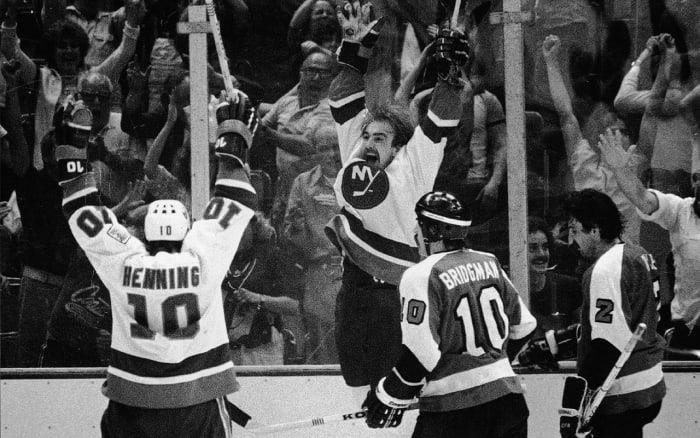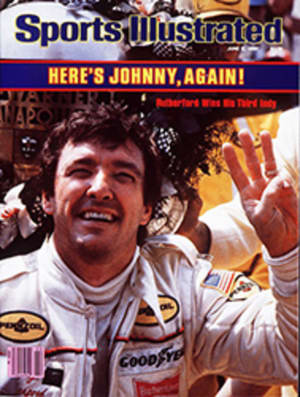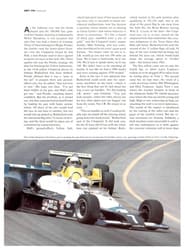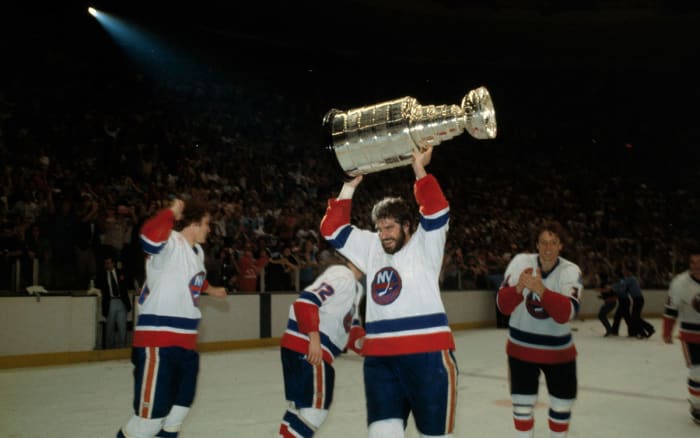Putting the Hammer to the Old Bugaboo
Pat Quinn, the jut-jawed, ramrod-erect coach of the Flyers, had slyly called it "That old bugaboo from their past," but the headlines in the Philadelphia newspapers were not that subtle, ISLANDERS—CHOKE! they implied. Indeed, the New York Islanders have regularly worn the Choke! label in recent Stanley Cup playoffs, and several times last week they once again seemed ready to snatch defeat from the jaws of victory.
The Islanders had beaten the Flyers 5-2 Monday night at the Nassau Coliseum to take a three-games-to-one lead in the finals, but with a chance to bury forever their image as chokers and win the Cup, they had been blown out of the Spectrum 6-3 by Philadelphia Thursday night in Game 5. And now, as 14,995 long-suffering Long Islanders look on in horror Saturday afternoon, there are telltale signs of throat grabbing out on the slushy ice—a swimming pool, really—in the mercilessly muggy Coliseum.
The Islanders led the Flyers 4-2 after two periods and were only 20 minutes from a champagne bath, but in their usual fashion they allowed the feisty Philadelphians to tie the game at 4-4 and force a sudden-death overtime. Gulp. And as the O.T. begins, Islander Goal-tender Billy Smith, who had played poorly in Game 5 and not much better in the regulation time of Game 6, looks so shaky that he doesn't seem capable of stopping a basketball, let alone a hockey puck.
Bobby Clarke rifles a shot for the corner high to Smith's right side. Smith never moves. The puck flies inches over the crossbar and smacks against the glass. Ken (Rat) Linseman, everyone's enemy, gets the puck alone in front of Smith but waits far too long to shoot. Islander Defenseman Bob Lorimer throws his body at the puck, and muffles the shot. Smith falls on it and sighs with relief.
Almost seven minutes into sudden death, Islander Coach Al Arbour sends out his third line of Lorne Henning, John Tonelli and Bob Nystrom. Henning is an Islander original, a survivor of the 1972-73 season when the expansion Islanders, their roster littered with rejects and smooth-faced 20-year-olds like Henning, won only 12 of 78 games and were the butt of tired jokes cracked by the haughty Rangers. Over the years Henning developed into a competent penalty killer, but this season he lost even that spare-parts job. He dressed for only 39 of the Islanders' 80 games and was skating in the playoffs only because Anders Kallur had suffered a disabling shoulder injury.
Tonelli is a hunched-over, plodding skater who makes his living along the boards and scores his few goals—just 17 this season—on rebounds or deflections; he played for the Houston Aeros in the WHA when that team went belly-up financially, and when he joined the Islanders at the end of the 1977-78 season, he probably didn't realize how close they were to being bankrupt themselves. The owner at the time had spent his hockey earnings on a pro basketball team, and only an infusion of new ownership and fresh cash kept the Islanders out of receivership and on Long Island.
Like Henning, Thore Robert Nystrom is an Islander original. The Hammer of Thor they called him during those early losing years; Nystrom may have been a good fighter, but he wasn't much of a hockey player. He couldn't skate; he'd take a couple of strides, trip over one of the lines and fall flat onto the ice. The Islanders finally hired skating instructor Laura Stamm to work with Nystrom. That fairly titillated Nystrom's opponents, who kept asking him about his Triple Salchows. But Nystrom stopped falling down every few strides and became a solid third-line right wing—that is, a dependable checker and someone good for more than 20 but not more than 30 goals a season. He also became the Islanders' main man in the clutch, scoring the winning goal in three overtime playoff games before the Philadelphia series. And earlier in Game 6, with time running out in the second period, Nystrom had given the Islanders their 4-2 lead by rapping Tonelli's perfect goal-mouth pass past Flyer Goaltender Pete Peeters.
And now Henning has the puck in his own half of the ice, between the blue and red lines. He passes it across the red line to Tonelli, the best Islander player this day, who is cutting into the middle from left to right. Tonelli swoops across the Philadelphia blue line and bears down on Defenseman Moose Dupont. Suddenly Tonelli spots Nystrom breaking for the net on his left, a half stride ahead of Defenseman Bob Dailey, and threads a perfect pass onto Nystrom's stick. Like most NHL players in this age of the slap shot, Nystrom uses a stick with a boomerang curve. Because of the bend in the blade, he cannot backhand the puck with any authority; in fact, he remembers no backhanders among his 21 goals this season. But now he thrusts his stick at the sliding puck and backhands it up into the air and over the sliding Peeters into the net.
Team Choke didn't, at last. And the Stanley Cup belonged to the Islanders, the first New York team to win it since the 1940 Rangers.
"We had to do it the hard way," Nystrom said. "For the past three years we've been doing things the hard way. Did you really think we'd change now?"
Before the game, though, the Islanders professed no doubts about winning the Cup on their home ice. "People can say what they want about us," said Center Bryan Trottier. "Sure, we've lost in the playoffs before when we were supposed to win, but you don't necessarily choke when you lose." At Friday's brief skate, Smith was flipping pucks out of the rink so practice would end sooner, and Arbour declared firmly, "This is our last practice this year." Right Wing Mike Bossy seemed more annoyed than disturbed by Quinn's comments about the old bugaboo. "At this point, we've heard it all before," Bossy said, "and you don't have time to care about who thinks what."
On Saturday, TV cameramen were all over the Coliseum, shooting what the local folks, anyway, hoped would be the finish of hockey's interminable season. The Islanders and Flyers had met in the opening exhibition of the preseason last September 22, and they had played 111 and 109 games, respectively, since then. For the first time in six years an NHL game was being telecast nationwide—CBS had managed to bump a bicycle demolition derby in Des Moines—and both teams intended to provide dramatics for whatever audience tuned in.
Early on, there was a glimpse of just how tightly strung both clubs were. With the game just one minute old, Flyer Paul Holmgren and Islander Gord Lane staged a high-sticking duel, and 12 more penalties were assessed by Referee Bob Myers before the first period ended.
But the most controversial call was one that Linesman Leon Stickle didn't make. With the score tied at 1-1 following goals by Philadelphia's Reggie Leach and the Islanders' Denis Potvin, New York Wing Clark Gillies skated down the left boards, crossed the Flyers' blue line and dropped the puck back to trailing Center Butch Goring, who was busting for the blue line. The puck clearly passed back across the blue line and into the center-ice zone before Goring collected it and moved it over the blue line himself.
Stickle should have whistled an offsides—and called for a face-off in neutral ice. But he gave a safe sign and play continued. Goring shot a pass over to Right Wing Duane Sutter, and Sutter lifted the puck over Peeters for a 2-1 Islander lead.
"I guess I blew it," Stickle said after seeing a replay. "The puck came back across the line. Maybe there was black tape on Goring's stick and it confused me. Or maybe I was too close to the play. I just missed it."
The Flyers argued long and loud about the missed offsides, but got nowhere. "We're not going to make excuses," said Philadelphia Captain Mel Bridgman, "but that goal had to change the momentum to their side."
Whatever momentum the Flyers lost because of the non-call, though, they seemed to regain 4:50 later when Brian Propp took a Holmgren pass in front of the net, spun around and slammed the puck past Smith to tie the score at 2-2.
Still haunted by the ghost of playoffs past, the Islanders settled down to play solid hockey in the middle period, Bossy scoring early on the power play after Trottier worked the puck from behind the cage and then Nystrom giving New York its 4-2 lead at 19:46. But the Islanders also missed several other good scoring opportunities. Once Nystrom skated in alone on the Flyer net but was knocked down from behind by Defenseman Behn Wilson and went tumbling into Peeters. The goalie's head cracked against the post, and he was knocked cold. Once revived, Peeters stayed in the game.
As the third period began, Islander history began repeating itself. Rather than resume the attacking style that had produced four goals and had limited the Flyers to a mere 12 shots at Smith over two periods, New York inexplicably went into a defensive shell. But such strategy—"Why they do it I'll never know, but they always do," Arbour said—has never worked for the Islanders, and it didn't work against the Flyers. After several Flyer near misses and a season's supply of New York defensive blunders, Dailey blasted a slap shot past Smith from the blue line, cutting New York's lead to 4-3. A few minutes later, with the Islanders still looking lost, the Flyers tied it up when John Paddock deflected Dupont's blue-line shot into the net.
"They were freaky goals," said Smith. "Dailey's just went wide of the net, hit someone and went in. And on Paddock's, they had three guys standing in the slot and the puck slid in between their feet. Did I panic? I was scared skinny."
But if the chunky Smith was scared, his teammates remained calm—outwardly so, anyway. "When we went back out there for overtime, we knew what we had to do, that's all," said Bossy. Grimly determined now and drenched from exertion, the Islanders returned to the ice to a great ovation. A fan dressed as the Stanley Cup—inverted garbage can for the base, spray-painted birdbath up top—paraded around the rink. A banner in the balcony pleaded, LET'S WIN THIS ONE, I WORK TUESDAY NIGHT. The Islanders, too, would be laboring Tuesday if they fizzled in O.T. "Going back to Philadelphia would have been an awful lot of trouble, big trouble," Bossy said. "Nobody wanted to go back."
Except the Flyers, of course. They had compiled the NHL's best record over the 80-game regular season and had set a league mark by going 35 games without a defeat, but as Clarke said, "The only thing people ever remember is who won the Stanley Cup."
Philadelphia had the edge in the early moments of overtime as Clarke, Linseman and Al Hill took aim at Smith. But then—at 7:11—it was Nystrom's moment. "All I had to do was shovel the puck in," he said, ignoring the fact that there was some artistry involved, too. It was a beauty of a goal, the little sweep on the backhand and the deflection up and in. Even before Nystrom had completed his swing, the red light blazed and the Coliseum was a solid wall of noise.
Islander General Manager Bill Torrey watched his team skate a victory lap with hockey's crown jewel and beamed when someone offered him a paper cup of champagne. As builder of the Islander franchise and rescuer of the team from bankruptcy two summers ago, Torrey had often talked about his long-run game plan. When he was named G.M. of New York's expansion franchise in 1972, Torrey promised no results right away but indicated that by Year 4 or 7 or 8 the Stanley Cup would be on the horizon. If you buy the eight-year version, the Torrey system is right on schedule, although Torrey still insists that last season's team—the best in the NHL during the regular season—had the talent, if not the temperament, to win it all.
Instead, the 1980 Islanders—No. 5 during the 80-game season—finished No. 1 in the end. Along the way they set a playoff record by scoring 25 power-play goals, including a stunning 15 against the Flyers, and the 23-year-old Trottier, the 1979 NHL scoring champion but a playoff bust the last four seasons, set a point-scoring record (29) as he won the Conn Smythe Trophy for being the MVP of the playoffs.
Four original Islanders remain from the hapless days of the '70s—Gary Howatt, Smith, Henning and Nystrom. One Islander, Defenseman Ken Morrow, has been with the team for less than three months; before that, Morrow was helping the U.S. win the gold medal at Lake Placid. The team averages 25 years in age and four years in NHL experience.
"The difference in this series? We scored more goals than they did," said Gillies as he sipped a beer instead of the bubbly. "We really don't realize this whole thing yet. It might hit us in a week. I know I'll still be up tomorrow. But when everything calms down here, I'm going home where I have a bottle of champagne in the refrigerator. It's been there since Christmas, and I've been waiting for something special to drink it. And when I have a nice, calm drink of it, instead of squirting the stuff like in here, then I'll realize what we've done."
Nobody chokes on champagne.
PHOTO
Nystrom, the Hammer of Thor, jubilantly skates off to celebrate the goal that won the Cup for New York. A second earlier he'd beaten Philly's Peeters with a backhand shot off a feed from Tonelli.
PHOTO
Islander Goaltender Billy Smith went down too soon and couldn't stop this scoring shot by the Flyers' Brian Propp, but he managed to survive a shaky overtime.
PHOTO
Irate Mel Bridgman complained long and loud, but the officials wouldn't change a crucial call.
PHOTO
For Clark Gillies, hoisting the Cup was easy.



